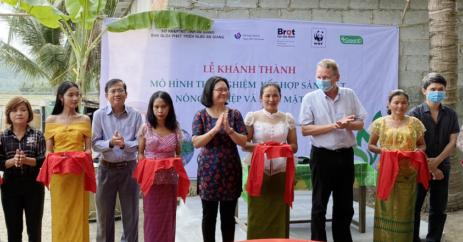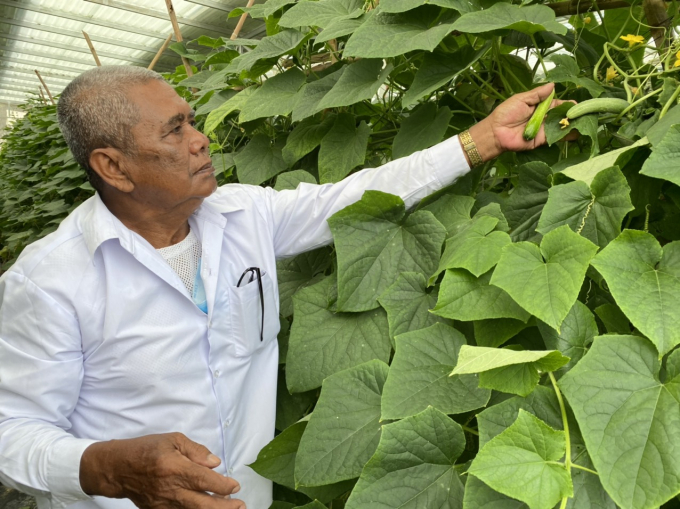May 21, 2025 | 04:42 GMT +7
May 21, 2025 | 04:42 GMT +7
Hotline: 0913.378.918
May 21, 2025 | 04:42 GMT +7
Hotline: 0913.378.918

An Giang Province’s Department of Agriculture and Rural Development and Green Innovation and Development Centre (GreenID) inaugurated a pilot model combining solar power generation and agriculture production in Tri Tôn District. Photo: Le Hoang Vu.
Sustainable Energy Development Project Management Board under An Giang Province’s Department of Agriculture and Rural Development, Green Innovation and Development Centre (GreenID)- a Vietnamese non-profit organisation and their partners have organised a ceremony launching a pilot model combining solar power generation and agriculture production.
Earlier, since May 2020, solar panels were installed in a farming land of a local household in An Hoa hamlet, Chau Lang Commune, Tri Ton District. The installation was completed and connected to the power grid in December 2020 and started generating power from early 2021.
The solar power system with a capacity of 45kwp are installed on the area of 400 sq.m, under which is a net house. The solar panels are designed to ensure crops could grow well under them.
The solar power system can generate 103 kWp daily. Between January and March 2021, the project sold more than 4,471 kWh equally to over VND 22 million.
Chau Hon whose farming land is used for the project said that he started growing cucumber in the net house under solar panels in February 2021.

Cucumber is grown under solar panels in Chau Hon’s farm in Tri Ton District. Photo: Le Hoang Vu.
The cucumber in the net house grew better than that grown in conventional farming areas, he said, adding that his family harvested over 30 kg of cucumber daily and could sell a kilo of cucumber for VND10,000.
“The cucumber looks good, tastes good and my consumers like it very much,” he said.
Truong Kien Tho, vice director of An Giang Province’s Department of Agriculture and Rural Development said that the combination of solar power generation and agriculture production was new in the province but step-by-step produced positive results.
Many people believed that crops would not grow well under the solar panels.
“However, if we can choose proper crops to grow, we can earn both from cultivation and power generation,” he said, adding that the combination was expected to help local farmers turn more prosperous.

(VAN) Japan's grant aid project contributes to capacity building, promoting organic agricultural production, and fostering sustainable community development in Dong Thap province.

(VAN) For years, the CRISPR-Cas9 genome technology has been reshaping genetic engineering, a precision tool to transform everything from agriculture to medicine.

(VAN) Vietnam aims to become a 'leader' in the region in the capacity and managing effectively soil health and crop nutrition.
![Reducing emissions from rice fields: [Part 1] Farming clean rice together](https://t.ex-cdn.com/nongnghiepmoitruong.vn/608w/files/news/2025/05/05/z6509661417740_a647202949c539012a959e841c03e1d3-nongnghiep-143611.jpg)
(VAN) Growing clean rice helps reduce environmental pollution while increasing income, allowing farmers to feel secure in production and remain committed to their fields for the long term.
/2025/05/19/5136-1-144800_230.jpg)
(VAN) The Nghe An Provincial People's Committee has just approved the list of beneficiaries eligible for revenue from the Emission Reductions Payment Agreement (ERPA) in the North Central region for the year 2025.

(VAN) 14 out of 35 domesticated elephants in Dak Lak province have had their living conditions improved, with 11 of them currently participating in the non-riding elephant tourism model.

(VAN) Muong Nhe Nature Reserve hopes that being upgraded to a national park will lay the foundation for forest protection efforts to be carried out in a systematic, modern, and sustainable manner.